Protected bike lanes coming to Varick and Church this month
The Department of Transportation will start installing a protected bike lane down Varick/West Broadway and up Church/Sixth Avenue from Laight to Barclay this month, similar to the ones in Chelsea on Seventh Avenue (see image below).
And wait, there’s more! There are also bike lanes coming to Murray, Park Place and Barclay to manage bike traffic to and from the Brooklyn Bridge. (Thanks to the heads up from Charlie Komanoff. This was presented to CB1 in February but I missed it.) The bike lane will go down the east side of Varick/West Broadway — where it is now — and up the west side of Church/Sixth — the opposite of where it is now, and has a plan for the pinch point at Tribeca Park. (Note that in the diagrams below, the cars are coming at you, so you are standing in the street looking the wrong way, which can be confusing.)
This is huge news, but it also has implications for our new curbside seating establishments. I have a note into DOT to see what their plan is for those with significant setups — thinking about Odeon, Serafina, Tribeca’s Kitchen, etc.
And just for a little data, bike commuting is way up in the city over the past 10 years (the comparison to cities like Portland, where there are only 650,000 people, is a little silly, but still, you get the idea) and the city’s protected bike lane network has exploded in 20 years.







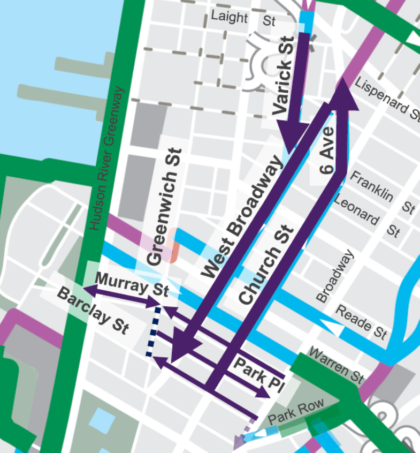
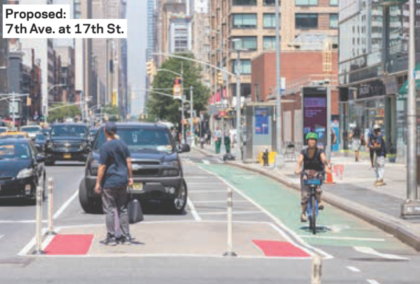
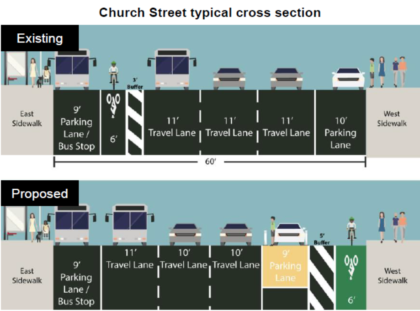
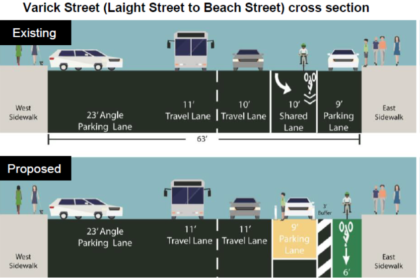
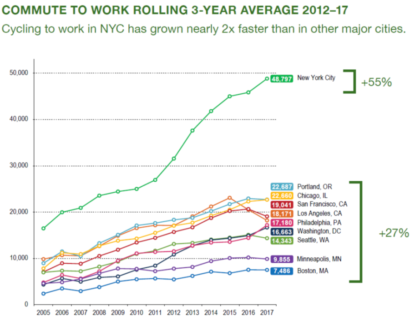
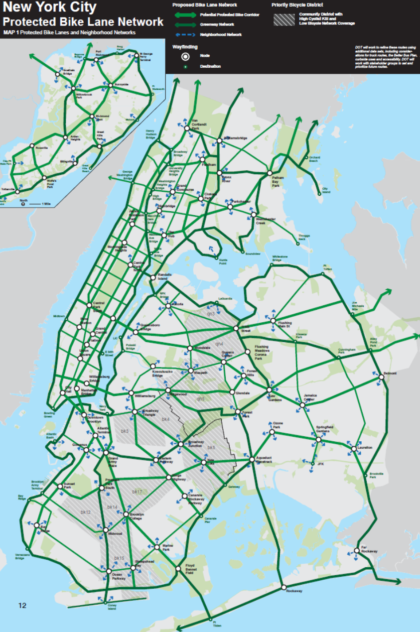






DOT is taking up all kinds of road space not to accommodate the 50,000 who commute to work throughout NYC by bicycle, but rather to dissuade the 700,000 or so who commute into the Manhattan CBD by car, by reducing road capacity for cars. Adding bike lanes is the administratively and politically easiest way to re-configure roads for fewer cars in NYC.
Good work by DOT here, though they undermine their position with their silly commute-to-work-by-bicycle stat — a datum that grossly understates bike usage by (i) counting only bike trips *into* the CBD, which ignores the greater number of trips *within*, and (ii) excluding non-work trips — to school, ferrying kid(s) to school, shopping, errands, appointments, etc. That said, James, I think you’re giving the agency more anti-car cred than they deserve. Taking lanes out of general circulation is a byproduct, not the main motive.
Yeah, I don’t know why DOT would bother with that misleading stat. A quick Google search shows a DOT estimate of 490k rides/day using data from like 2017, so the post-covid number will be significantly higher once everything is fully back in action. There are also e-scooters to think about. That segment is growing like crazy (they’re cheap, quick, no gas, no sweating, etc.) and can fit into bike lanes no problem. You need to give these modes safe spaces to operate to keep them off of sidewalks and away from pedestrians.
https://www1.nyc.gov/html/dot/downloads/pdf/cycling-in-the-city.pdf
Streetsblog just posted their story on the traffic / streetscape / transportation platforms of the nine Council candidates running to succeed CM Chin: https://nyc.streetsblog.org/2021/05/07/decision-2021-nine-candidates-vie-to-represent-lower-manhattan/
Noticed the newly striped streets by Varick/W. Bway/N. Moore yesterday. It’s a very nice improvement. It also seems like the NYPD on Varick/Beach is adhering to the new parking lane rather than angling into what was previously a shared bike lane on the east side of Varick. Angled parking still exists on the west side of the street, but this change looked much more orderly. Hopefully it stays like that.
As to restaurants, I’m pretty sure they will have to move their outdoor setups out of the bike lane and into the new parking lane. Amsterdam on the UWS has a similar | Sidewalk – Bike Lane – Buffer – Parking – Car Traffic | street layout and all of the outdoor dining setups are in the parking lane with the bike lane and buffer clear.
Now maybe the bicyclists will get the heck off the sidewalks!
Maybe they’ll follow the flow of traffic, stop at lights, and respect pedestrians as well. But I have little hope for it. Several times per week I am almost hit by a biker who has absolutely no regard for people with the right away in crosswalks.
“almost”
sure you are.
With Injuries Piling Up Across New York City, Mayor De Blasio Is Considering Bicycles Being Required To Have License Plates – CBS New York
https://newyork.cbslocal.com/2021/05/17/new-york-city-bicycles-license-plates-vision-zero-bill-de-blasio/
Now we need truck deliveries to be done from midnight to 6:00AM. With the bike lane + a car parking lane, the trucks park in a traffic lane for deliveries, reducing the traffic lanes by one. Also think they should restrict car parking on Varick as you approach the tunnel, again you have trucks double parked, reducing an already reduced traffic flow corridor. I guess we need to reduce car traffic – period.
RE G’s comment: How about a touch of reality?
How do you expect these midnite to 6:00 AM deliveries to be made to your/our neighborhood stores? Almost all of which (except bars, 24-hour McDonalds) close well before midnight and open after 6:00 AM.
I am not a store owner, nor related to one, merely dealing with the real world as it exists, not a utopia that doesn’t.
Time to start receiving overnight deliveries.
Any suggestions how OR just being quixotic? I see you answered at 2:15 AM, so not an issue for you. How should the merchants pay for the additional costs OR does everyone shop at Target?
@Ben
Yes, merchants should be tasked with figuring out how to make overnight deliveries work, and those that do it well, i.e. manage to hold down costs without sacrificing (or perhaps even enhancing) the customer experience, will be richly rewarded with more customers and greater profits. Why, the world may even beat a path to their door! But workers are constantly being asked to adapt to new market conditions, e.g. lower wages, less benefits, new skill requirements, technological innovation, industry obsolescence, etc., so why shouldn’t businesses have to innovate when new conditions arise? Particularly when the changes would greatly increase the quality of life of the neighborhood inhabitants who largely make up their customer base?
Less Cars will actually harm Business and Commerce in
the area where the new bike lanes are being placed.
About half of the bike users don’t even us the Bike Lanes.
Never true. I ran a small business org for years and the myth that cars equal more business is just so untrue. Foot traffic. and in part bike traffic are far ahead of car traffic in driving business to stores. Its not like we have large walmarts in manhattan
I agree with you Patrick. Manhattan businesses need those of us pounding the pavement. I cycle everywhere but also have a car which my NYC born husband uses 99% of the time and the government has a good idea of who all those vehicles are and what their purpose in the city is. A lot of them have single drivers too.
Very few people drive to businesses in this area. You have locals that come on foot and workers that arrive via public transportation primarily.
You may be right or not. Have any statistics or numbers on how many drive? Of course the number exists, but would be more persuasive if you were specific.
So glad this is happening. NYC needs a restructure of its streets to make it a better place to live.
Good news to this long time cyclist!
about time! my commute to work every day is on this route, and having a protected bike lane is going to change my life (and the lives of the hundreds of others who bike around me).
and of course, the lunch i order comes from a mostly immigrant workforce on bikes, who must be protected in order to truly be living in a “fair” city.
@Paul We live in this NYC reality & NOT utopia.
Is public (and you) prepared to pay addt’l costs when passed-along to customers? Perhaps you prefer that businesses unable to meet the higher cost just close?
Look around Tribeca: see many empty storefronts, see how many businesses are closed to never to return., say ‘hello’ to the real world. Maybe you can afford to pay more for your quality of life issues, but many are not in that position. Bikes do not drive the economy; they enhance your (& others) quality of life. Many more people want to sleep through the night than ride bikes. Yes a generalization like yours, but more in line with reality (& easier to defend). Or do you expect that somehow that cost of night time deliveries will not be passed on and that’s just ‘cost of doing business.’
You’ can advocate for such, but economic reality has a seat at the table and plays a strong hand. To say nothing of those residents who prefer sleeping through the night to waking up to 3:00 AM delivery trucks unloading. Of course if you live far enough up in a high rise than this is not a consideration.
You can certainly speak of your own quality of life but claiming that it applies ‘”o the neighborhood inhabitants who largely make up their customer base” is generalization far from reality. How about those who commute and only work here.. Maybe you’d like to supply some statistics when making such a broad claim?
Time to go back to sleep for me: it’s Sunday morning and no deliveries to wake me up.
@Ben
You ask whether the public is prepared to pay higher costs to compensate merchants for the expense of rearranging their delivery schedules to accommodate a more pedestrian (and bike) friendly cityscape and my response is — “yes, they will until they won’t.” By that I mean, every business regulation imposes costs and those costs are borne (ultimately) by the business’ customers, but customers will stop patronizing a particular business as soon as the cost begins to outweigh the utility of the product or service on offer. So, as my initial comment stated, those businesses that adapt and innovate to changing conditions (like nighttime deliveries) while minimizing costs borne by their customers will likely do very well while their competitors who don’t manage the extra cost efficiently won’t (and, yes, may eventually even go out of business.) But rock bottom prices can’t be the end-all-be-all goal. If that were the case then we’d still have child labor, unsafe and unhealthy working conditions and total disregard for business’ impact on the environment. As with all things, what we need is a healthy, sustainable balance between the private interests of business owners to make a profit and the public interest in walkable, rideable, livable streets and communities. Personally, I don’t think it’s an all-or-nothing equation.
Let’s see what results NYC comes up with once it completes its legally mandated study of overnight deliveries to City government facilities located in congested areas.
L.L. 2019/184
Enactment date: 10/26/2019
Int. No. 1140-A
By Council Members Constantinides, Rodriguez, Levin, Levine, Rosenthal, Kallos, Cohen and Miller
A Local Law in relation to off-hour deliveries at city facilities
Be it enacted by the Council as follows:
Section 1.
a. Definitions. For the purposes of this section, the following terms have the following meanings:
Central business district. The term “central business district” means the area of the borough of Manhattan lying south of and including 60th street.
City facility. The term “city facility” means a facility used or occupied or to be used or occupied to meet city needs that is located on real property owned or leased by the city or is operated by the city pursuant to a written agreement on behalf of the city.
Highly congested areas. The term “highly congested areas” means at least two areas of the city outside of the central business district in which there are both high levels of traffic congestion and high densities of city facilities, as determined by the agency or office designated by the mayor pursuant to subdivision b of this section.
Lower Manhattan. The term “lower Manhattan” means the area of the borough of Manhattan lying south of and including Canal street.
Off-hour deliveries. The term “off-hour deliveries” means the delivery of goods between 7:00pm and 6:00am.
b. No later than 180 days after the effective date of this local law, an agency or office designated by the mayor shall, in consultation with other agencies or offices as deemed appropriate by the mayor, develop a framework for the feasibility of city facilities in the central business district and highly congested areas receiving off-hour deliveries and shall submit a report on such framework to the mayor and the speaker of the council. Such report shall include, but need not be limited to, the following:
1. A discussion of the problems that currently exist with respect to daytime deliveries at city facilities;
2. A discussion of the existing models of off-hour delivery programs in both the public and private sectors;
3. Recommendations for actions that the city could take to expand off-hour deliveries to city facilities;
4. An assessment of the feasibility of deploying personnel to receive off-hour deliveries at city facilities;
5. Recommendations for actions that the city could take to enable off-hour deliveries without the presence of personnel;
6. Recommendations for actions that the city could take to reduce adverse impacts on communities adjacent to city facilities receiving off-hour deliveries, including through the use of low-noise equipment and operating procedures; and
7. Recommendations for processes through which building and facility delivery and service plans could best be created, implemented and refined over time for city facilities, including through delivery scheduling, vendor consolidation and safer and more environmentally sustainable freight vehicles.
c. No later than 270 days after the effective date of this local law, the agency or office designated by the mayor pursuant to subdivision b of this section shall assess all city facilities in lower Manhattan to determine whether off-hour deliveries are feasible at such facilities and such agency or office, in consultation with other agencies or offices as deemed appropriate by the mayor, shall conduct off-hour deliveries at such facilities.
d. No later than 18 months after the effective date of this local law, the agency or office designated by the mayor pursuant to subdivision b of this section shall submit a report to the mayor and the speaker of the council regarding off-hour deliveries at each city facility at which off-hour deliveries were implemented pursuant to subdivision c of this section. For each such facility, such report shall include the number of deliveries, the provider of the goods delivered and the value of the goods delivered that have been diverted to off-hours deliveries and any measures taken to increase off-hour deliveries.
e. No later than 18 months after the effective date of this local law, the agency or office designated by the mayor pursuant to subdivision b of this section shall assess all city facilities in the central business district and highly congested areas that are not in lower Manhattan to determine whether off-hour deliveries are feasible at such facilities and such agency or office, in consultation with other agencies or offices as deemed appropriate by the mayor, shall conduct off-hour deliveries at such facilities.
f. No later than two years after the effective date of this local law, the agency or office designated by the mayor pursuant to subdivision b of this section shall submit a report to the mayor and the speaker of the council regarding off-hour deliveries at each city facility at which off-hour deliveries were implemented pursuant to subdivision e of this section. For each such facility, such report shall include the number of deliveries, the provider of the goods delivered and the value of the goods delivered that have been diverted to off-hours deliveries and any measures taken to increase off-hour deliveries.
§ 2. This local law takes effect immediately
@Paul “Rock Bottom Prices” is not the goal nor is your desire to limit deliveries. A sustainable economic & traffic model is the goal. NYC cannot be all things to all people all the time. Choices must be made. It’s America, so feel free to advocate for whatever you desire, but to equate ‘rock bottom prices [with] . . . child labor, unsafe and unhealthy working conditions’ is a false equivalency. As for a total disregard for business’ impact on the environment’ is there less of an impact if the truck is unloading at 3:00 AM than at 3:00 PM. Isn’t the issue your inconvenience with trucks parking when you’re bicycling?
I also conclude from your comment that “competitors who don’t manage the extra cost efficiently won’t (and, yes, may eventually even go out of business)” that you are an advocate of economic Social Darwinism. You should remember that’s a two-edged sword.
With all the bike lanes WHY must inconsiderate cyclists speed down the BPC esplanade hitting people and nearly killing seniors and toddlers
One walkway is all we want
Brookfield Plaza Does NOT enforce its own rules
Sadly
It’s going to take the death of a child or senior on the BPC esplanade to get anyone to listen
Sad situation